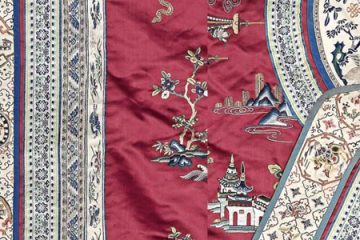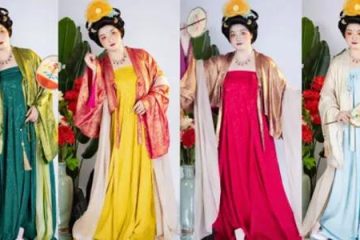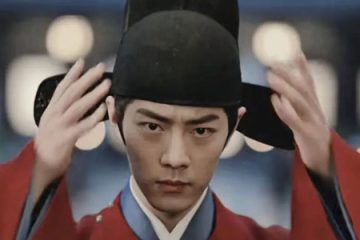What Exactly Is the Development History of the Cheongsam?

We’ve talked so much about Hanfu. Are there people who are curious about how the cheongsam came into being? Everyone knows that the cheongsam highlights a woman’s charm. In China, many people get married wearing a Western-style white wedding dress, while some choose to wear Hanfu, and there are also those who get married in a cheongsam.
Does the development of the cheongsam also follow a tortuous path like that of Hanfu? If you’re really interested in the cheongsam, you might as well read on.
I. Controversies about Its Origin
Some scholars believe that the cheongsam is the “robe worn by the Manchu people.” The Manchu clothing in the Qing Dynasty is its “ancestor.” During the late Qing Dynasty and the early Republic of China, influenced by social changes and Western culture, it gradually evolved into the cheongsam we know today.

Some scholars also point out that the origin of the cheongsam should date back to the more ancient Zhou, Qin, and Han dynasties. It’s not that only women in the Qing Dynasty wore robes. Therefore, they advocate changing the name from “旗袍” to “祺袍” to avoid disputes.
In modern times, the boundary between “traditional cheongsam” and “improved cheongsam” has become blurred, and there have been a lot of debates in the fashion industry.
We won’t go into too much detail about the specific origin and classification here. Of course, if any of you have specialized research on cheongsams, you can leave a message in the comment section to provide reverse popular science for everyone.
Now, let’s follow SilkDivas and sort out the development history of the cheongsam according to the chronological development.
II. Traditional Cheongsam
1. 1910s
The Xinhai Revolution in 1911 overthrew the autocratic monarchy, and the style of clothing began to develop towards the direction of a democratic republic. The “upper garment and lower skirt” style, such as the ingot collar and jacket-pants, was the fashion trend at that time.
At that time, a slender figure was highly admired in society, so “looking slim” was the top consideration in clothing design. The ingot collar was the best “face-slimming tool” at that time. And the exposed wrists when the sleeves were tightened was also a bold breakthrough at that time.

2. 1920s
With the launch of the May 4th Movement and the New Culture and New Life Movement, clothing was also greatly influenced. Western design elements, such as the square collar, round collar, and heart neckline, etc., began to be widely used in the early 1920s.
The silhouette of the jacket and the long coat no longer blindly pursued the “narrow and slender” effect. For example, the following two photos can be regarded as the precursor of the cheongsam that has not been fully evolved.

In the late 1920s, the early form of the cheongsam featured “large flared sleeves + loose tailoring“, which was different from the image of “showcasing a curvy figure + high slits” that most people have in mind.
What we refer to as the “traditional cheongsam” nowadays generally refers to this type.
This one-piece cutting and loose silhouette don’t place high demands on one’s figure. Girls look good and feel comfortable wearing it, so the cheongsam became increasingly popular at that time.

3. 1930s
In the 1930s, the sleeves of the cheongsam became completely short. Exposing the arms was no longer a big deal. On the contrary, the collar became tight and high. Although the decorative frog buttons on it are really beautiful and delicate, people with thick necks might feel a bit uncomfortable.

At the same time, the hem of the cheongsam became longer, turning into an extra-long style that could cover the instep. Most of the slits were below the knees, so the legs wouldn’t be exposed when walking.

4. 1940s
In the 1940s, the appearance of the cheongsam gradually became simpler. Some elaborate frog buttons were replaced by side zippers, and the sleeves became shorter and shorter. The shoulder-length sleeves at that time, in my opinion, are not much different in length from modern sleeveless shirts.

“Sloping shoulders” have always been a standard for evaluating beautiful women in traditional Chinese aesthetics. However, in the 1940s, Western-style shoulder pads were first added to the design of the cheongsam. Along with the elements of sheer fabrics that reveal a hint of the body, it has many similarities with some modern designs.
5. 1950s (Hong Kong and Taiwan regions)
In the 1950s, cheongsams in the Hong Kong and Taiwan regions became more “westernized“. The waist-cinching tailoring, similar to a corset, could really shape one’s figure into an “hourglass shape“. Coupled with the bullet bras that were popular in the United States at that time, the S-shaped curve was well-executed.

During that period, Chinese and Western cultures were in a stage of mutual exchange and integration. The cheongsam was not simply westernized. Instead, it became a “new favorite” in the West.
In 1956, Grace Kelly, an Oscar-winning actress and the Princess of Monaco (yes, the princess after whom Hermès renamed its classic bag, the Hermès Kelly, in 1956), attended the Golden Globe Awards ceremony in the United States wearing a qipao dress.
By the way, this princess is truly a classic figure who has led the fashion trend. If you want to see a series about classic fashion figures, feel free to leave a message and I’ll dig into it for you later.

6. 1960s (Hong Kong and Taiwan regions)
In the 1960s, cheongsams in Hong Kong became even more form-fitting, continuing the hourglass silhouette trend from the 1950s.

Just like Su Lizhen in the movie In the Mood for Love, form-fitting cheongsams could be considered the “commuting attire” for Hong Kong women. When walking on the street, you could see many women in cheongsams everywhere you looked.

As there were more and more styles of clothing to choose from, the cheongsam was no longer an everyday outfit. Instead, it leaned more towards being a formal dress or performance wear. Miss Teresa Teng, who was both beautiful and had a sweet voice, was a fan of cheongsams. Many other artists also tried to interpret cheongsams in new styles. After the year 2000, a new term, “improved cheongsam,” came into being.

III. Improved Cheongsam
Up to now, by adapting the cheongsam according to modern aesthetics and lifestyle, it has gained a much larger audience.
I’ve roughly made some classifications. Most of the improvements are based on the following aspects:
1. Making the frog buttons less practical
For the convenience of putting on and taking off, most of the improved cheongsams have replaced the hand-made frog buttons with zippers. The frog buttons are merely used as decorative embellishments. Our website also has similar designs, such as this Bamboo Serenity.

2. The height of the slits and the form-fitting tailoring
Also for the sake of “convenience and attractiveness”, many of the improved cheongsams now follow the Y2K (Year 2000) style favored by trendy girls. They give a new interpretation of the originally elegant and sexy cheongsam. For example, in the works of the BY2 group from the millennium era, in the music video Peach Blossom Cheongsam, the two of them wear cheongsams that highlight a new Chinese style. Although, in my personal aesthetic view, the cheongsams don’t fully bring out their beauty, cheongsams with a “distinctive personality” have indeed been born. The improved cheongsam is gaining momentum, and there may well be broader development prospects in the future.

3. Improvements in materials
The most intuitive impression I get from improved cheongsams is that “anything can be made into a cheongsam.” Whether it’s the patterns or the materials, as long as they’re suitable, they can be used to create a cheongsam.

In fact, the creation of improved cheongsams is a very “down-to-earth” move. Since traditional cheongsams have already been surrounded by a cultural aura, people inevitably think they’re “not practical for daily wear.” Even if they love them, they’ll still wonder how many times they can actually wear one.
The improved cheongsam, on the other hand, is more accessible for everyday wear. People with different styles can all find a cheongsam that suits them.

Summary
I think whether one chooses the “traditional style” or the “improved style” of the cheongsam dress, it’s all out of love for the cheongsam and a desire to show one’s affection for Chinese culture. It’s just that the ways of expressing this love are different.



0 Comments